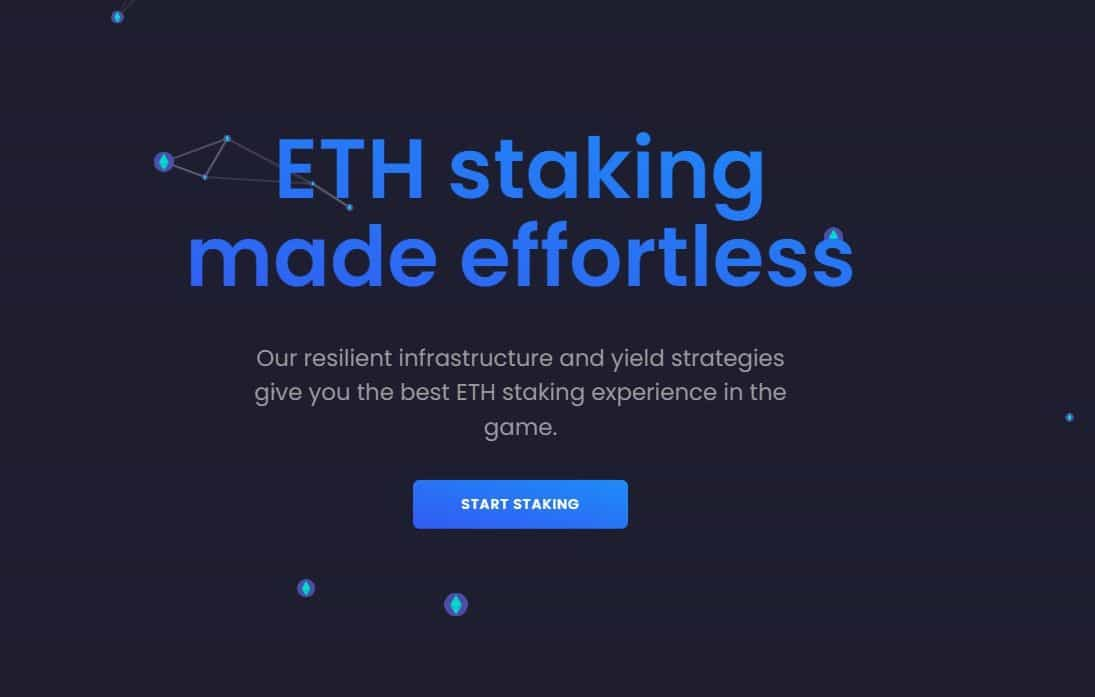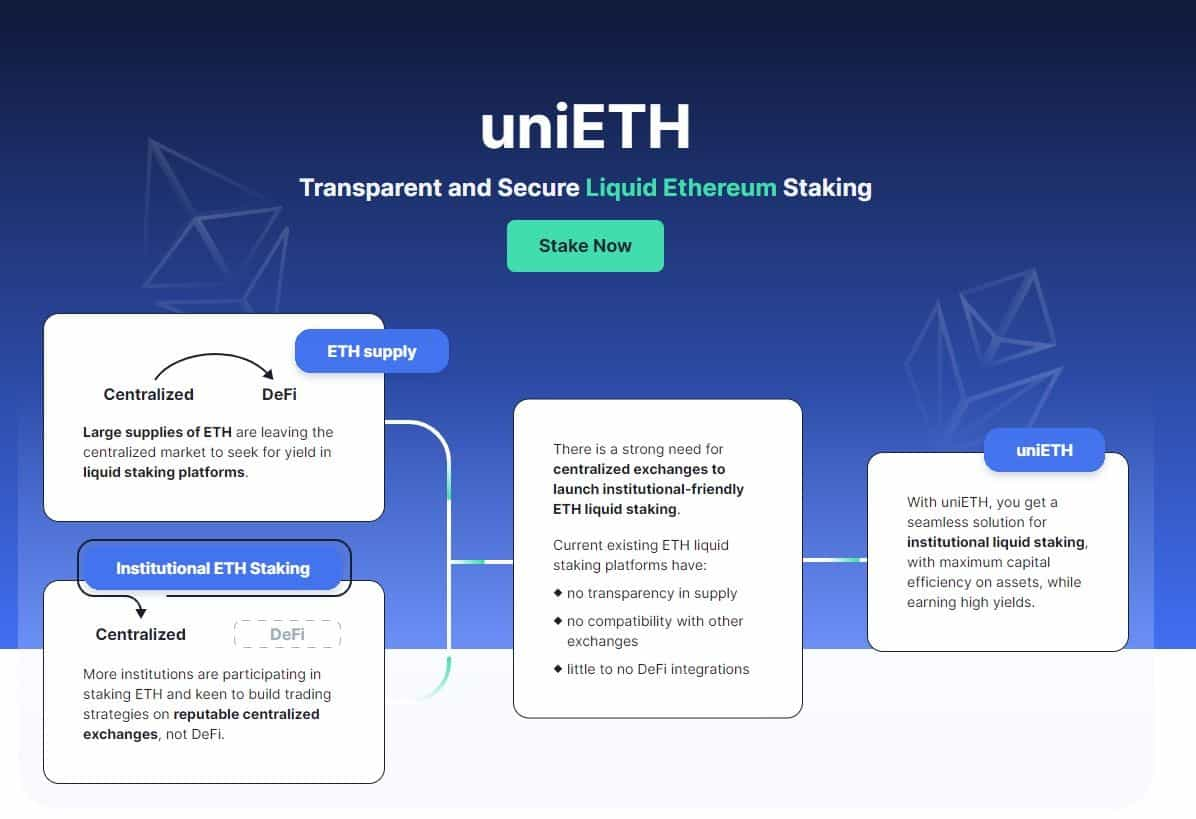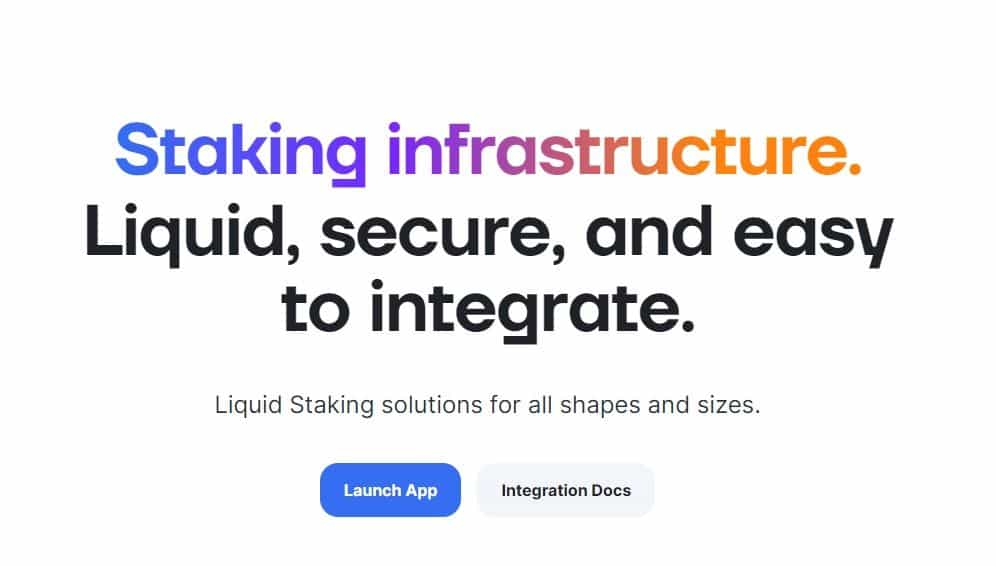Best ETH Staking Pools in 2024: Where to Stake Ethereum!
Staking unused crypto is fast becoming a reliable avenue for enthusiasts to participate in blockchain networks while earning rewards. Whether it's running a personal validator node, staking directly on exchanges, or opting for the more accessible route of staking pools, versatility is another key attraction of crypto staking.
Staking pools have gained prominence as an affordable option for anyone looking to venture into crypto staking. These pools aggregate the resources of multiple participants, allowing them to combine their staking power and increase the likelihood of validating transactions and earning rewards. We'll go into greater detail later in the article. However, if you've ever wondered about the intricacies of staking, our How and Where to Stake Ethereum guide should be right up your alley.
While the concept is straightforward (lock up ETH and earn rewards), navigating the ecosystem of Ethereum staking pools can be a daunting task. This article aims to serve as a guiding beacon (see what I did there?) through the intricacies of staking, shedding light on the best Ethereum staking pools.
What is Ethereum Staking?
Before I delve into Ethereum staking, let's first take a brief look at Ethereum's journey to a proof-of-stake (PoS) consensus.
Ethereum started as a proof-of-work (PoW) project similar to Bitcoin, which still follows the same consensus. In a PoW system, participants (known as miners) compete with each other to solve complex mathematical problems. Whoever solves the problem first is rewarded with newly created cryptocurrency and transaction fees. Dogecoin, Litecoin and Zcash are also among examples of a PoW consensus.
In September 2022, Ethereum shifted to a PoS model in what is often referred to as “The Merge.” PoW's energy consumption is one of its most significant criticisms because the process of solving complex mathematical problems requires a massive amount of computational muscle. According to the Cambridge Bitcoin Electricity Consumption Index, the annualized energy consumption of the Bitcoin network is roughly 105 terawatt-hours (TWh), more than some countries. Following "the Merge," Ethereum's energy consumption plunged by about 99.95%.
If you're looking for a more detailed comparison between PoW and PoS, we have just the right article for you. We also have an in-depth article on why the concerns over Bitcoin's energy usage are greatly exaggerated.
Today, Ethereum enjoys a dominant position in the crypto world thanks to its pioneering smart contracts functionality, market recognition and network effects. All this has translated into a total value locked of $24.54 billion, the highest for any blockchain — PoS or not.

In a PoW system, participants are referred to as miners. The terminology used in a PoS model is validators because you're verifying transactions on the blockchain. In Ethereum staking, participants are chosen to create new blocks and validate transactions based on the amount of ETH they hold and are willing to "stake" as collateral.
If you're looking to stake Ethereum, there are three ways you can go about it:
- DIY
- Staking on exchanges
- Staking pools
We'll touch on the first one here and go into detail on the other two later in the article.
The DIY strategy entails setting up your own validator node, which is a fancy way of saying setting up your own server. While this approach may seem suitable to Ethereum purists, there are a few problems with this.
- High Minimum Staking Requirement: If you're looking to become an independent validator on the Ethereum network, you need to lock up at least 32 Ether as collateral. As of Nov. 22, 32 ETH were valued at over $63,500.
- Hardware Cost: You'll need a powerful computer to run a node. Recommended hardware includes a fast CPU with 4+ cores with at least 16 GB of RAM and 1 TB of storage space.
- Technical Complexity: Running an independent node involves technical tasks, including setting up and maintaining the node, dealing with software updates and troubleshooting potential issues. For those who aren't technologically aligned, this may prove to be a challenging endeavour.
- 24/7 Uptime: Validators are expected to maintain a high level of uptime. This means you'll have to invest in backup systems and reliable internet connectivity to ensure 24/7 availability.
Not exactly a cakewalk, right? Turning to the top Ethereum staking pools may be your best option unless, of course, you have a hole burning in your pocket.
Why Stake Ethereum?
For anyone willing to lock up 32 ETH in a cryptocurrency wallet to support the operations of the Ethereum network, there are several benefits to be had.
- Earn Staking Rewards: This is one of the primary drivers of staking Ethereum. Validators, who play a role in securing the network and validating transactions, are rewarded with ETH for their participation. If you deposit more than 32 ETH for a single validator, your rewards will not increase. If you're solo staking, you'll cut out the middleman, ensuring all the rewards are yours to keep.
- Participate in Network Security: You contribute to the security and decentralization of the Ethereum network by staking ETH. According to BeaconScan, the number of validators on the Mainnet Beacon Chain currently stands at over 1 million. However, Ethereum's “decentralization” is a contentious topic, with many outspoken critics becoming disappointed in how centralized the project has become.

- Encourages HODLing: Staking Ethereum means locking up your ETH for a certain time. Staking encourages participants to "HODL" their Ethereum rather than sell it.
- Potential for Capital Appreciation: If the price of Ethereum appreciates over time, the value of your staked ETH also increases. For example, imagine staking ETH when it was at $50, compared to someone who does it now when the digital asset is changing hands at about $2,000. Capital appreciation can contribute to a more attractive return on investment.
Risks of Staking Ethereum
While staking Ethereum offers the potential for earning rewards and supporting the network, it isn't all shiny and chrome and there are several pitfalls associated with it as well.
- Slashing Risk: Slashing occurs when a validator provably acts against the Ethereum network. Slashing doesn’t need to have malicious intent and could happen from misconfiguration. When this happens, the system removes (or "slashes") a portion of the offending validator's existing stake. This will result in a slow bleed of your staked ETH until the validator is forcefully ejected. Slashing is irreversible.
- Downtime Penalties: Validators are expected to maintain a high uptime. If a validator's node experiences significant downtime, it can lead to penalties, reducing the overall staked amount and potential rewards.
- Market Volatility: ETH's value can be subject to significant market volatility. If the price decreases while it is staked, the value of the staked assets in fiat currency terms may decrease. Participants may be exposed to market risk, especially if they get cold feet during a market downturn and choose to unstake.
- Uncertain Returns: Network conditions, the total amount of staked ETH and validator performance are just some of the things that influence staking rewards. While staking returns can be variable, actual rewards may differ from expectations.
- Operational and Technical Challenges: Running a node requires technical expertise. Challenges like hardware failures, software issues or connectivity problems can impact the overall performance of the validator.
Staking on Exchanges
Staking Ethereum on exchanges provides an alternative for individuals who may not have the technical expertise or the minimum staking amount required to run an independent validator node. Here are a few centralized exchanges that let you stake ETH.
- Binance: The largest exchange's Binance Earn program allows you to earn money via crypto. It features saving and lending products, as well as ETH staking. The APR currently on offer is 3.52%. For more information, head over to our full Binance Earn review where we explore the benefits and risks.
Important: As part of a recent settlement with the US government, Binance will completely exit the country. Binance is also not available in the UK.
- Kraken: Kraken's bonded ETH staking product will fetch you an APR of between 3% and 6%. There are currently no transaction fees for staking or unstaking, but Kraken targets a commission of 15% based on the rewards you receive from the network.
- Coinbase: Another credible exchange offering Ethereum staking is Coinbase, which offers up to 3.16% APY if you hold on to the asset for one year. You can earn rewards by staking as little as $1 worth of on Ethereum. Our full Coinbase review provides in-depth information on the exchange's Earn products as well as fees.
- eToro: eToro, one of the few exchanges authorized to do business in the UK, offers 4.3% rewards per year on staked ETH. However, crypto staking is currently unavailable for users based in the UK and US.
Disclaimer: Don't invest unless you're prepared to lose all the money you invest. This is a high-risk investment and you should not expect to be protected if something goes wrong.
Here are a few items to take stock of before you stake Ethereum on an exchange.
- Custodial Risk: Staking on exchanges involves trusting the exchange with your staked ETH. If the exchange faces security breaches (which are common) or financial issues, you might up losing all of your money.
- Loss of Control: Users staking on exchanges have less control over the staking process compared to running an independent validator node. They rely on the exchange's infrastructure and decisions regarding upgrades or changes to the staking protocol.
- Fees: Before you stake ETH on an exchange, you should first review any fees associated with staking and the withdrawal process.
Despite these drawbacks, there are several advantages to staking on an exchange as well.
- Lower Entry Barrier: Staking Ethereum on exchanges makes the process accessible to a broader audience. Users who do not have the minimum 32 ETH required to run an independent validator node can still participate.
- Convenience: If you're currently using an exchange for your crypto needs, choosing that platform would be more convenient than setting up your own system. It would allow you to stake and manage assets within the familiar interface of the exchange without dealing with the complexities of running a node.
- Free of Technical Expertise: Don't have technical knowledge? No problem. Staking on exchanges eliminates the need for users to possess technical knowledge about setting up and maintaining a validator node. The exchange handles the technical aspects of staking, which makes it a more user-friendly option.
- Top-notch Security Measures: Reputable exchanges implement security measures to protect users' staked assets. This includes secure storage solutions, encryption, and other safeguards to prevent unauthorized access and potential security threats.
Best Ethereum Staking Pools
Here are some Ethereum staking pools that are recognized for their reliability and popularity.
Lido
Lido is an open-source ETH staking pool, providing users with a decentralized staking solution. It's also the biggest Ethereum staking pool. One standout feature of Lido is its substantial liquidity, which tops $19.14 billion. In addition to Ethereum, Lido also operates on the Polygon blockchain. It stopped supporting Solana in October due to the termination of development and technical support of Lido on Solana.

This robust liquidity empowers users to seamlessly convert their staked ETH (stETH) tokens into other assets, offering increased flexibility and opportunities within the decentralized finance (DeFi) ecosystem. By choosing Lido for staking, users receive stETH tokens, representing their staked ETH along with accrued rewards, offering an APR of 3.6% for ETH. Thus far, Lido has paid over $944 million in rewards.
Turning to security, the Lido DAO codebase has been audited by industry leaders in blockchain security, and it also uses the Immunefi platform — the leading bug bounty platform for DeFi with the world's largest bounties. In addition, Lido conducts a continuous review of all code.
Lido applies a 10% fee on staking rewards that are split between node operators and the DAO Treasury.
RocketPool
RocketPool may not be as large as Lido, but it is the only staking platform with a perfect score on ethereum.org. Its total value locked stands at $2.41 billion, a fraction of Lido's.

Here's a snapshot of RocketPool.
- $1.71 billion has been staked with the protocol, representing 2.9% of all staked ETH.
- The pool currently has 3,373 node operators.
- Rocket Pool has value alignment with the ethos of Ethereum — permissionless, non-custodial, trustless, decentralised and open source.
- RocketPool's smart contracts have been extensively audited many times by some of the best auditors in the Ethereum ecosystem.
ETH liquid staking offers an APR of 3.26%, while that for node staking is 7.10%. RocketPool takes a 14% cut from your rewards.
Stakewise
StakeWise runs a robust infrastructure for its node operators, ensuring the constant availability and security of validators to prevent any penalization.

Beyond its commitment to node operation, StakeWise offers integration with numerous DeFi projects, providing users with strategies to enhance their staked ETH earnings. The platform also delivers real-time monitoring, furnishing users with insights into validator rewards and performance. It's TVL, according to DefiLlama, is $217.9 million.
StakeWise is currently working on the third iteration of the protocol. StakeWise V3 will allow anyone who is capable of running Ethereum validators to participate in liquid staking and receive staking delegations from others. StakeWise V3 is a permissionless and decentralized staking protocol. Its goal is to reduce the degree of stake centralization on Ethereum by:
- Making solo staking more appealing,
- Putting the choice of node operator(s) into the user’s hands
- Offering a new, less risky staked Ether token standard as an alternative to prevailing models
StakeWise's fee is 10% and the APR is 4.24%.
Bedrock
RockX launched Bedrock, its proprietary liquid staking protocol, earlier in 2023. Bedrock implements enterprise-grade security measures and adheres to AML/KYC compliance standards. The platform offers flexibility by allowing users to maintain anonymity, especially for those looking to stake smaller amounts.

Users receive Universal ETH (uniETH) tokens by staking ETH on Bedrock. This token is AML regulation compliant, independent and verifiable, professionally managed and agnostic to both centralized and decentralized exchanges. Crafted with a focus on the distinct requirements of institutional clients, the platform also caters to the needs of the retail sector.
Bedrock was developed as the pioneering liquid staking protocol that integrates with secret shared validator (SSV) technology. By distributing the validator key across multiple non-trusting nodes, the protocol enhances decentralization, fault tolerance, and overall security. In addition, the implementation of a hybrid cloud architecture, backup nodes, and continuous 24/7 monitoring systems is in place to mitigate the risk of a single point of failure. To reinforce its reliability, the Bedrock protocol has undergone a thorough audit conducted by Peckshield, a renowned industry audit firm.
No information is available on Bedrock's fee or APR. However, RockX charges a 20% commission on fee rewards, which is 3 of 6% of overall rewards, and there's no fee on protocol rewards. The APR is currently 3.97%.
Ankr Staking
Ankr supports several tokens such as ETH, MATIC and DOT, among others. To start staking, visit Ankr Staking and link your wallet from the available supported wallet choices. The company currently supports Trust Wallet, Metamask, WalletConnect as well as the Ledger Nano X and S Plus, among other wallets.

Ankr offers institutional-grade security, underpinned by a smart contract security audit conducted by Beosin and Salus Security. The platform further fortifies its security framework through a bug bounty program, which encourages the community to identify and report potential vulnerabilities. The validators' keys are safeguarded in a non-custodial, hardware-backed key manager.
Ankr charges a 10% fee from the staking reward. It's currently offering an APR of 3.56% on Ethereum staking.
How Much Can You Earn Staking Ethereum?
Several factors come into play to determine your earnings from staking ETH. Here are key factors that influence potential earnings:
- Staking Rate: The staking rate, or the percentage of total Ethereum being staked on the network, affects rewards. Generally, higher staking rates may result in lower individual staking rewards, and vice versa.
- Validator Performance: Validators are responsible for proposing and validating blocks. Their performance, including uptime and adherence to network rules, influences rewards. Validators who consistently perform well likely receive higher rewards.
- Network Conditions: The overall health and activity of the Ethereum network can impact staking rewards. A network with increased transaction volume and activity may generate higher fees, contributing to higher rewards for validators.
- Economic Variables: Economic factors, such as changes in the price of Ethereum, can impact the value of staking rewards. If the price of ETH increases, the value of staking rewards in fiat currency terms also goes up.
- Validator Commission Fees: Validators charge a commission fee on the rewards they distribute to stakers. Higher commission fees result in lower net returns for stakers.
- Staking Period: Ethereum staking involves locking up funds for a certain period. The longer the staking period, the higher the potential rewards. However, this also means that the staked ETH is locked and cannot be accessed during the staking period.
Top Ethereum Wallets for Staking
While Ethereum staking support in wallets is somewhat limited, MyEtherWallet expanded its offerings to include staking options. Users can engage in full validator staking with 32 ETH through Staked.us, or opt for liquid staking via StakeWise and Lido.
Exodus is another wallet that facilitates Ethereum staking by allowing connection to Lido through both its Web3 wallet and mobile app. Additionally, MetaMask provides staking capabilities for ETH through Lido and Rocket Pool.
If you're in the market for an ETH storage solution, check out our article on the best Ethereum wallets.
Best Ethereum Staking Pools: Closing Thoughts
For anyone considering staking Ethereum, there are multiple approaches — setting up a DIY validator node, staking on exchanges, or joining staking pools.
While running an independent node offers control, it comes with high minimum staking requirements, technical complexity, and the need for constant uptime. Staking on exchanges provides a more accessible option for individuals lacking technical expertise, although it introduces custodial risks. Staking pools offer a balance between control and convenience.
Ultimately, the decision to stake Ethereum depends on individual circumstances, technical capabilities, and risk appetite. Whether you opt for the hands-on approach of running your own node or choose the convenience of staking on exchanges or in pools, understanding the associated benefits and risks is crucial for a successful staking experience.
Frequently Asked Questions
The best place to stake Ethereum depends on individual preferences, risk tolerance, and technical expertise. Each platform has its pros and cons, and users should evaluate factors such as fees, security measures, and user experience before choosing a staking provider.
The safest way to stake Ethereum involves using reputable and secure staking platforms or exchanges that have implemented robust security measures. Platforms with a track record of security audits, adherence to compliance standards, and transparent operational practices are generally considered safer.
Ethereum staking rewards are typically distributed at regular intervals, with the frequency varying based on the specific staking platform or pool. Common payout intervals include daily, weekly, or monthly distributions.
Staking Ethereum on Coinbase is generally considered safe, as Coinbase is a well-established and reputable cryptocurrency exchange. Coinbase implements security measures such as encryption, two-factor authentication, and cold storage for the majority of user funds. However, users should be aware of custodial risks associated with staking on exchanges.
Determining the "best" Ethereum staking pool depends on individual preferences, priorities, and specific requirements. Some widely recognized and popular staking pools include Lido, RocketPool, StakeWise, and Bedrock.
Staking ETH carries certain risks that users should be aware of:
- Slashing Risk: Validators may face slashing if they violate network rules, resulting in a reduction of their staked amount.
- Downtime Penalties: Validators with significant downtime may incur penalties, impacting overall staked amounts and rewards.
- Market Volatility: ETH's value is subject to market fluctuations, and stakers may be exposed to potential losses during market downturns.
- Uncertain Returns: Staking rewards are influenced by various factors, and actual returns may differ from expectations.
- Operational and Technical Challenges: Running a validator node requires technical expertise, and users may encounter challenges related to hardware, software, and connectivity.
Whether ETH staking is worth it depends on individual goals, risk tolerance, and preferences. Staking offers the potential for yield through earned rewards and contributes to the security of the Ethereum network. However, users should carefully consider the associated risks, market dynamics and their own technical capabilities before going down this road.
Disclaimer: These are the writer’s opinions and should not be considered investment advice. Readers should do their own research.


